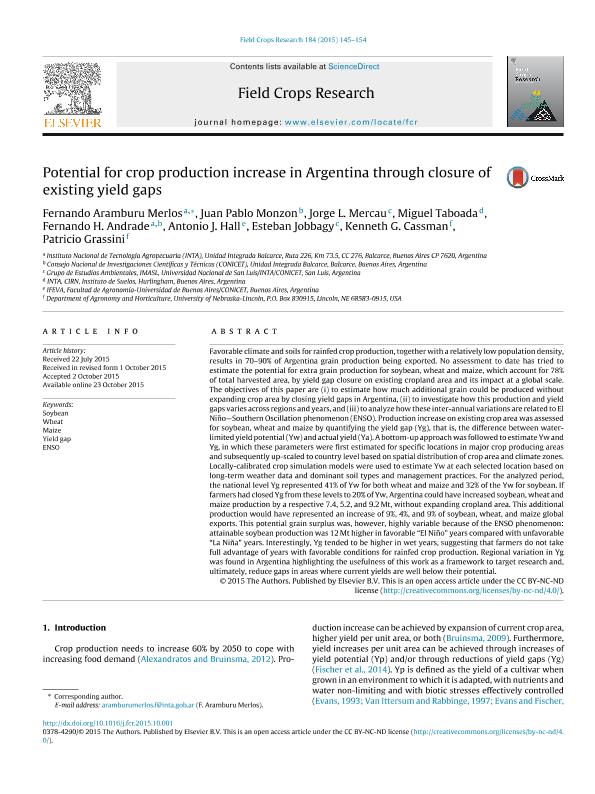Mostrar el registro sencillo del ítem
dc.contributor.author
Aramburu Merlos, Fernando
dc.contributor.author
Monzon, Juan Pablo

dc.contributor.author
Mercau, Jorge Luis

dc.contributor.author
Taboada, Miguel Angel

dc.contributor.author
Andrade, Fernando Héctor

dc.contributor.author
Hall, Antonio Juan

dc.contributor.author
Jobbagy Gampel, Esteban Gabriel

dc.contributor.author
Cassman, Kenneth G.
dc.contributor.author
Grassini, Patricio
dc.date.available
2018-03-09T20:34:56Z
dc.date.issued
2015-12
dc.identifier.citation
Aramburu Merlos, Fernando; Monzon, Juan Pablo; Mercau, Jorge Luis; Taboada, Miguel Angel; Andrade, Fernando Héctor; et al.; Potential for crop production increase in Argentina through closure of existing yield gaps; Elsevier Science; Field Crops Research; 184; 12-2015; 145-154
dc.identifier.issn
0378-4290
dc.identifier.uri
http://hdl.handle.net/11336/38485
dc.description.abstract
Favorable climate and soils for rainfed crop production, together with a relatively low population density, results in 70-90% of Argentina grain production being exported. No assessment to date has tried to estimate the potential for extra grain production for soybean, wheat and maize, which account for 78% of total harvested area, by yield gap closure on existing cropland area and its impact at a global scale. The objectives of this paper are (i) to estimate how much additional grain could be produced without expanding crop area by closing yield gaps in Argentina, (ii) to investigate how this production and yield gaps varies across regions and years, and (iii) to analyze how these inter-annual variations are related to El Niño-Southern Oscillation phenomenon (ENSO). Production increase on existing crop area was assessed for soybean, wheat and maize by quantifying the yield gap (Yg), that is, the difference between water-limited yield potential (Yw) and actual yield (Ya). A bottom-up approach was followed to estimate Yw and Yg, in which these parameters were first estimated for specific locations in major crop producing areas and subsequently up-scaled to country level based on spatial distribution of crop area and climate zones. Locally-calibrated crop simulation models were used to estimate Yw at each selected location based on long-term weather data and dominant soil types and management practices. For the analyzed period, the national level Yg represented 41% of Yw for both wheat and maize and 32% of the Yw for soybean. If farmers had closed Yg from these levels to 20% of Yw, Argentina could have increased soybean, wheat and maize production by a respective 7.4, 5.2, and 9.2. Mt, without expanding cropland area. This additional production would have represented an increase of 9%, 4%, and 9% of soybean, wheat, and maize global exports. This potential grain surplus was, however, highly variable because of the ENSO phenomenon: attainable soybean production was 12. Mt higher in favorable "El Niño" years compared with unfavorable "La Niña" years. Interestingly, Yg tended to be higher in wet years, suggesting that farmers do not take full advantage of years with favorable conditions for rainfed crop production. Regional variation in Yg was found in Argentina highlighting the usefulness of this work as a framework to target research and, ultimately, reduce gaps in areas where current yields are well below their potential.
dc.format
application/pdf
dc.language.iso
eng
dc.publisher
Elsevier Science

dc.rights
info:eu-repo/semantics/openAccess
dc.rights.uri
https://creativecommons.org/licenses/by-nc-sa/2.5/ar/
dc.subject
Enso
dc.subject
Maize
dc.subject
Soybean
dc.subject
Wheat
dc.subject
Yield Gap
dc.subject.classification
Agricultura

dc.subject.classification
Agricultura, Silvicultura y Pesca

dc.subject.classification
CIENCIAS AGRÍCOLAS

dc.title
Potential for crop production increase in Argentina through closure of existing yield gaps
dc.type
info:eu-repo/semantics/article
dc.type
info:ar-repo/semantics/artículo
dc.type
info:eu-repo/semantics/publishedVersion
dc.date.updated
2018-03-02T17:34:16Z
dc.journal.volume
184
dc.journal.pagination
145-154
dc.journal.pais
Países Bajos

dc.journal.ciudad
Amsterdam
dc.description.fil
Fil: Aramburu Merlos, Fernando. Unidad Integrada Balcarce; Argentina
dc.description.fil
Fil: Monzon, Juan Pablo. Consejo Nacional de Investigaciones Científicas y Técnicas; Argentina
dc.description.fil
Fil: Mercau, Jorge Luis. Universidad Nacional de San Luis; Argentina
dc.description.fil
Fil: Taboada, Miguel Angel. Instituto Nacional de Tecnología Agropecuaria. Centro Regional Buenos Aires; Argentina
dc.description.fil
Fil: Andrade, Fernando Héctor. Unidad Integrada Balcarce; Argentina
dc.description.fil
Fil: Hall, Antonio Juan. Consejo Nacional de Investigaciones Científicas y Técnicas; Argentina
dc.description.fil
Fil: Jobbagy Gampel, Esteban Gabriel. Consejo Nacional de Investigaciones Científicas y Técnicas. Centro Científico Tecnológico Conicet - San Luis. Instituto de Matemática Aplicada de San Luis "Prof. Ezio Marchi". Universidad Nacional de San Luis. Facultad de Ciencias Físico, Matemáticas y Naturales. Instituto de Matemática Aplicada de San Luis "Prof. Ezio Marchi"; Argentina
dc.description.fil
Fil: Cassman, Kenneth G.. Universidad Nacional de San Luis; Argentina
dc.description.fil
Fil: Grassini, Patricio. Universidad de Nebraska - Lincoln; Estados Unidos
dc.journal.title
Field Crops Research

dc.relation.alternativeid
info:eu-repo/semantics/altIdentifier/url/http://www.sciencedirect.com/science/article/pii/S0378429015300599
dc.relation.alternativeid
info:eu-repo/semantics/altIdentifier/doi/http://dx.doi.org/10.1016/j.fcr.2015.10.001
Archivos asociados
